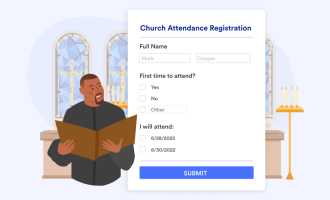Every Christian can remember a sermon that’s changed their lives. As a metaphysical, literary, and spiritual book, the Bible has the potential to engage our imagination, intellect, and mind on every level. Whether EV Hill’s “How to Make the Enemy Run” or David Platt’s “Divine Sovereignty,” a great sermon unalterably changes our perspective.
For the aspiring pastor, learning how to write a great sermon doesn’t happen all at once. Sermons are an art form in their own right. Writing a great one takes as much practice as it does for a composer writing a symphony. The best preachers work up to it after decades of experience.
Still, most sermons typically follow a particular pattern. Below are a few tips on how to get started.
1. Ideation
Writing a great sermon begins with a period of ideation. The actual writing and practicing phase will demand a lot of time and energy, so you want to choose a topic worthy of that time and effort.

The best way to start is with prayer. Long periods of silence, focus, and tuning in with the Holy Spirit are the best source of inspiration. According to Stephanie Douglas and Greg Robertson
“The sermon is an act of faith in and obedience to the Living God who continues to reveal Himself through the written Word proclaimed by the power of the Holy Spirit.”
If you want your sermon to resonate with the congregation’s faith, you have to begin with a creative act of faith on your part.
Paired with this is revisiting the scripture. Instead of completely restudying the Bible, it can be useful to skim it. As your eye tracks along the paragraphs, see if anything jumps out. Are there frequently misunderstood passages? Can etymology offer a more nuanced view? Sometimes letting the subconscious take over can be productive.
It can be tempting to immediately jump into writing and let inspiration move you. Don’t neglect this prep work, however. Like a cook sharpening their knives, a little contemplation makes the writing later on much easier.
2. Drafting
After some contemplation, it’s time to start formulating the basic foundations of your sermon. In the drafting phase, ask yourself a few more essential questions before beginning. What’s the form? What’s the flow? Who will listen, and why should they care? This is deeply skillful, empathetic work.

From the start, it’s useful to recognize what form your sermon will take. Different forms include
- How biblical principles apply to real life
- Breaking down a complicated idea
- Following a biblical narrative
- Addressing commonly misunderstood passages
And of course, there are more. Modeling your sermon off of others helps a lot.
It can be useful to create an outline. It doesn’t need to be complicated. Opinions vary, but many preachers find having sections and paragraphs listed at a glance helps them better grasp the flow and arc of their sermon. It also helps to list the scriptural passages on the outline so that you’re not constantly scrambling to find them. This is all important work that will ensure your sermon doesn’t get sidetracked when you start writing.
All of this prep will streamline your work in the rough draft phase. The best way to approach the first draft is to get it done. Just keep typing and let it rip.
3. Revision
During revision, you clean up and tweak all the messiness from the rough draft. This is when the tasteful, stylistic aspect of writing finally kicks in. Revising is typically the most enjoyable phase.

Rewrite everything from top to bottom until it’s satisfactory. At this point, the major mantra should be how the text is relatable to the audience. The tendency during the rough draft is to spew out everything you know. Expertise is needed, but without context, the audience will get bored. As you continue working over the piece, the more synthesis you can add, the better.
4. Delivery
Past a certain point, how the sermon is written becomes less important than how it reads. Only by reading aloud do you get a sense of the writing’s musicality.
Following sufficient revisions, start reading your sermon aloud. At first, do this alone. Like detecting an out-of-key note in music, reading aloud helps smooth over awkward passages in your writing that would’ve gone unnoticed otherwise. More than anything else, reading aloud activates your conscience of taste and allows you to be more critical.

Next, read aloud to a small audience. This is the best way to gauge the sermon’s pacing. It’s surprisingly easy to intuit when someone is bored. Whenever you feel the attention drifting during the test trial, mark the passage. It’s also useful to mark reminders for where to breathe, make eye contact, smile, or anything else. Over the course of a whole sermon, these little tweaks add up to a much better delivery.
Learning how to write a great sermon is a full-body workout for the mind. It engages scriptural knowledge, logic, taste, public speaking, and every other conceivable skill. Looking at this list, you can easily get overwhelmed.
Still, this is how every great preacher began mastering their craft. The important thing is to approach it step by step, and focus on each sequence as it happens. As these skills become more intuitive, you’ll become emboldened to try new things, speak in front of larger audiences, and be more excited to spread the faith.




















Send Comment:
3 Comments:
More than a year ago
Thanks for the work
Richly God bless you
More than a year ago
Faith can do a lot of things in your life if you let it. It will grow you and allow you to do things you never thought yourself capable of. I learned this at on faith and made a huge change on my life.
More than a year ago
I have been a faithful church-goer since I was a toddler. There was something that always drew me to the spiritual mindset. As I grew older, I got the chance to study the bible further and now I can say that I am a very proud practitioner of Catholicism.
I am preferring the church in my neighborhood since it brings the congregation closer and it is easier to access. But I just cannot feel and connect with the sermons that our current pastor is giving. He is just not planned enough that he is mostly all over the place and cannot get the beautiful messages across.
I wish my pastor would read this article, to better build his sermons so that the youth of our neighborhood would grasp the right message.
Thank you Father Sexton for taking the time to write this explanatory article, I also wish that I could listen to one of your sermons one day!